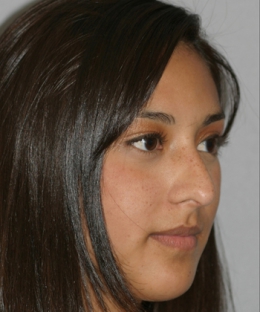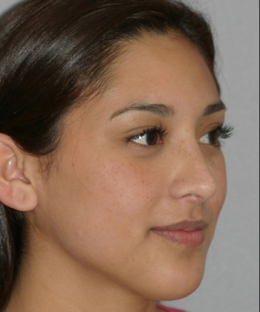Rhinoplasty
There are no set standards for the definition of a beautiful nose. Face shape, and contour, facial features, and opinion are all variables that help determine whether a nose is aesthetically pleasing. If you feel that a different nose would improve the appearance of your face, rhinoplasty, also known as a Nose Job, may benefit you.
Dr. Behmand performs rhinoplasty to help correct common concerns: big or wide nose rhinoplasty, short or long nose rhinoplasty, and droopy nose rhinoplasty. Reshaping may also be performed for a crooked nose, flaring nostrils, ethnic nose, deviated septum, and bulbous nose rhinoplasty. Dr. Behmand also performs revision nose surgery. His goal with rhinoplasty is to create a flattering nose shape proportionally to the rest of your face. The information below will provide further details about the rhinoplasty procedure, and setting up a consultation at our office.
Rhinoplasty Consultation
If you’re considering rhinoplasty, you’ve likely spent time evaluating your nose. During the consultation, Dr. Behmand will assess your concerns and discuss a surgical plan to enhance its shape and function. He’ll also consider factors like nasal structure, facial shape, and skin thickness. Be sure to share your complete medical history, including health, medications, allergies, breathing issues, past nasal surgery, and nose injuries.
During your consultation, our Patient Care Coordinator will provide you with information regarding surgery scheduling and costs, with a detailed breakdown of the surgical and anesthesia fees. Insurance policies do not cover cosmetic nose surgery. If you are coming from areas outside of Nashville or Tennessee, our office can help you coordinate your preoperative visit with your surgery to decrease travel needs and make efficient use of the time you spend in the Nashville area.
Preparing for Your Nose Reshaping Surgery
Before your surgery, you’ll need to avoid certain medications, limit alcohol intake, cease smoking two weeks before your rhinoplasty, and refrain from certain supplements and vitamins. You should arrange for someone to drive you to and from the surgery center and to take care of you for a few days after the operation. Most patients require only limited help after a rhinoplasty or septorhinoplasty. It is a good idea to prepare your house so that you will have a place to sleep with your head elevated for the first week after surgery. You can do this by sleeping with several pillows under your head and back, or by sleeping in a recliner chair.
Rhinoplasty FAQ’s
- Can a rhinoplasty be combined with other procedures?
- Of course! You can combine rhinoplasty with almost any other procedure. Certain procedures can complement the results of rhinoplasty. For example, a chin implant or genioplasty can enhance the results of your procedure by creating balance in the facial profile. Some patients prefer other unrelated procedures done at the same time to optimize their healing and recovery time.
- I’m having breathing issues, will insurance cover my rhinoplasty?
- In some situations, insurance might cover a portion of a septoplasty surgery, which is the internal portion of a “septorhinoplasty”. This is the procedure that corrects a deviated septum and alleviates certain breathing issues. Insurance rarely covers rhinoplasty because it’s deemed elective.
- At what age is a rhinoplasty appropriate?
- The ideal age for female patients is at least 16 years of age and older, and for male patients, 18 years of age and older. Before those ages, the nose and mid-face are still undergoing progressive growth. Surgery performed much earlier could result in less predictability of the outcome. If you have not yet reached the appropriate age, but have significant concerns that are negatively affecting your daily life, Dr. Behmand can see you, and your guardian for a consultation to determine your candidacy for surgery.
- I had a rhinoplasty with another doctor and am unhappy with the results; can you do a revision rhinoplasty?
- Yes, Dr. Behmand does perform revision, secondary and tertiary rhinoplasty procedures. This can sometimes be a more extensive process than your original rhinoplasty, so you should schedule a consultation with Dr. Behmand to see if you are a suitable candidate for this procedure.
The Rhinoplasty Surgery
We will perform your rhinoplasty surgery at our outpatient surgical facility in the Nashville area. We’ll administer general anesthesia to ensure you remain asleep and comfortable throughout the procedure. This helps to maximize comfort for you during the surgery, and maintains the safety of your airway. We may perform minor nose procedures under sedation.
During your rhinoplasty operation, we sculpt the nose bones and cartilages to the desired shape. The reshaping of your nose may require delicate repositioning of your nasal bones. The intricacies of rhinoplasty surgery, however, center more around the refinement of the nasal tip cartilages, proper reshaping of the middle portion of the nose, and delivering a balanced and natural-looking nose for your face.
Dr. Behmand performs both open and closed rhinoplasty. In open rhinoplasty, an incision is made in the columella for precision. Closed rhinoplasty involves incisions inside the nose, often with less swelling. Dr. Behmand will recommend the appropriate procedure during your consultation. After surgery, a splint is applied to maintain the new shape, along with internal splints if needed for internal nose work.
After Your Rhinoplasty Surgery
In most cases, you can return home the same day after nose surgery. If you’re from out-of-town or far away, plan to stay nearby for the first week. We’ll schedule a follow-up visit within 6 to 8 days and prescribe pain medication for your comfort. Keep your head elevated and nose splint dry to reduce swelling and ensure proper healing. Apply ice wrapped in cloth to your nose and forehead for the first 24 to 36 hours.
After rhinoplasty, keep head elevated for 48 hours. Swelling peaks in 2–3 days, improves by day 3, disappears in 7–10 days. Avoid blowing nose for 4 weeks. Remove splints in 7–8 days, sutures dissolve.
Post-surgery, swelling and bruising may occur but quickly fade, revealing a beautiful nose. Initial discomfort and low mood improve as the nose heals. Within 10–14 days, the surgical appearance diminishes, with residual swelling in the tip area gradually resolving over a year. However, others may not notice any remaining swelling within weeks.
“It has been a year since my surgery and I couldn’t be happier with the results. After my nose was crushed in a car accident, I thought I would never look normal, let alone beautiful, again. But Dr. Behmand’s work changed that! I now look better than I did before the accident! Thank you from the bottom of my heart, for my gorgeous nose (and the breasts are fantastic too!).”
Rhinoplasty Cost
How much does a nose job cost? The surgical fee for a primary rhinoplasty is $8,000, while a primary septorhinoplasty is $10,500. OR and anesthesia expenses add $5,000-$6,000. Costs vary depending on individual needs and OR time. Revision rhinoplasties are priced higher based on the required work.
To learn if rhinoplasty is right for you, contact our office to set up a personalized consultation with Dr. Ramin Behmand today.











